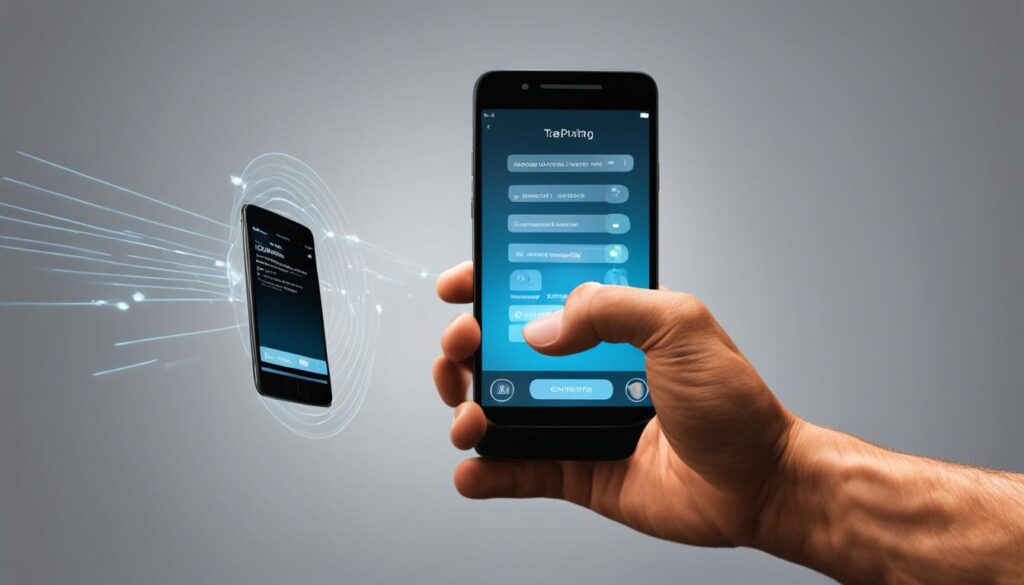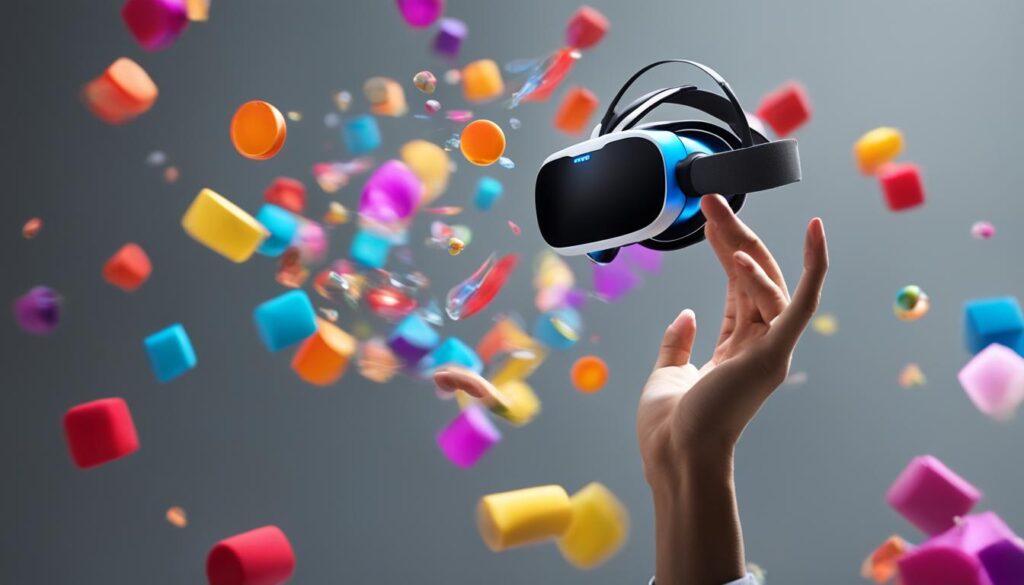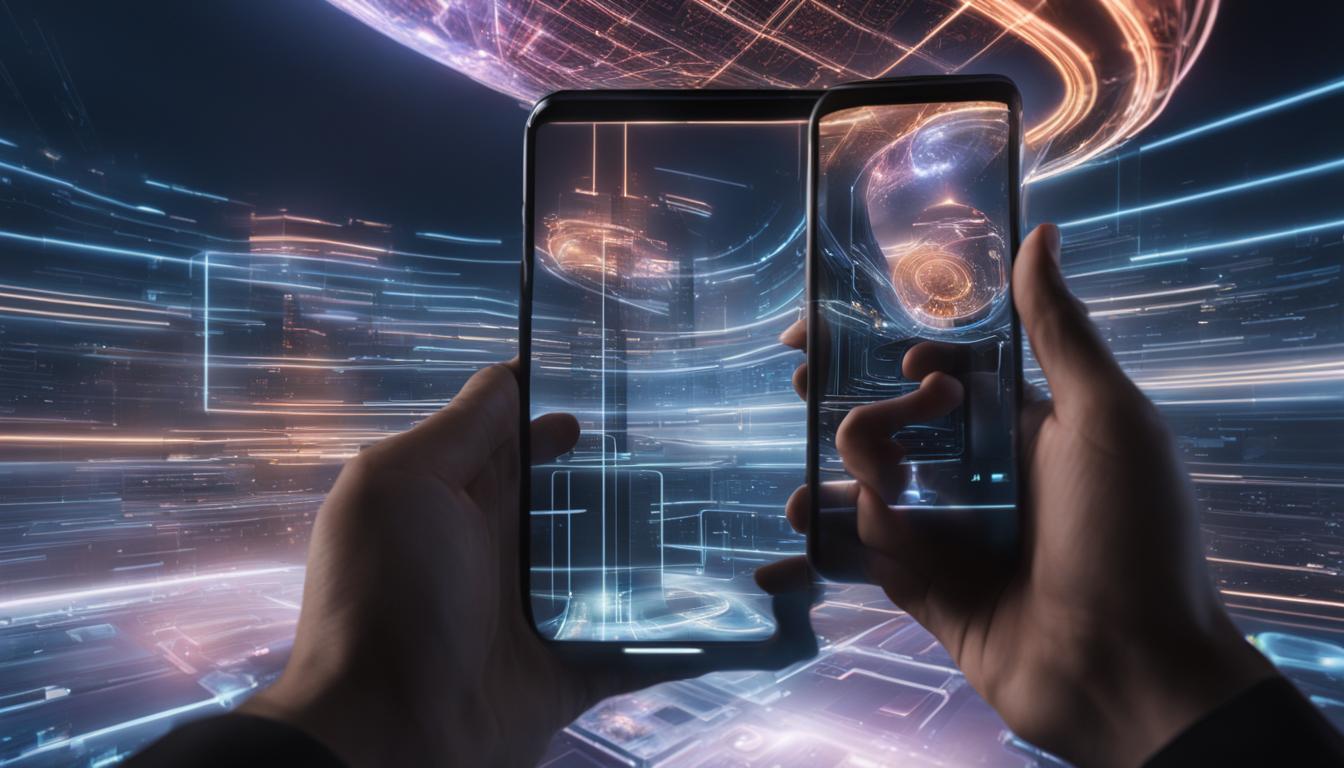Augmented Reality (AR) opens up a world of interactive experiences, allowing you to seamlessly blend the virtual and real worlds. But have you ever wondered how to touch and manipulate objects in AR? In this article, we’ll explore the exciting possibilities of touching objects in augmented reality and provide you with essential tips to enhance your interactive AR experiences.
Traditional AR apps often lack natural user interaction, making it challenging to directly manipulate 3D AR objects. However, a groundbreaking method has been developed that enables you to touch and interact with virtual objects in a more intuitive and realistic manner.
This revolutionary approach allows for natural hand gesture-based interactions on handheld devices. By employing touch and hand gestures, you can directly manipulate 3D AR objects in a real 3D space. This not only enhances the accuracy and intuitive nature of your interactions but also provides a more immersive and engaging AR experience.
Contents
- 1 The Importance of Natural Hand Gestures in AR Interaction
- 2 Design Considerations for Mobile AR Interactions
- 3 Interaction Challenges for Mobile AR
- 4 Overcoming Interaction Challenges in Mobile AR
- 5 Voice Interaction in AR Apps
- 6 Conclusion
- 7 FAQ
- 7.1 How can I interact with objects in augmented reality?
- 7.2 Why are natural hand gestures important in augmented reality?
- 7.3 What should I consider when designing interactions for mobile AR?
- 7.4 What challenges do mobile AR interactions present?
- 7.5 How can I overcome interaction challenges in mobile AR?
- 7.6 Can voice interaction be used in AR apps?
- 7.7 What are the best practices for optimizing AR interactions?
- 8 Source Links
Key Takeaways:
- Learn how to touch and manipulate objects in augmented reality for a more immersive experience.
- Discover the importance of natural hand gestures in enhancing AR interaction.
- Understand design considerations for creating effective mobile AR interactions.
- Explore the unique challenges and solutions for interaction in mobile AR.
- Find out how voice interaction can enhance AR experiences.
The Importance of Natural Hand Gestures in AR Interaction
Natural hand gestures are central to creating an immersive and intuitive augmented reality (AR) experience. When users can manipulate and interact with virtual objects using familiar gestures, the line between the real and virtual worlds blurs. This section explores the significance of natural hand gestures in AR interaction and how they enhance user experiences with augmented objects.
By incorporating natural hand gestures in AR, users can manipulate objects in a way that closely resembles real-world interactions. Imagine being able to reach out and grab a virtual object, rotate it, or move it around. These natural interactions not only provide a more realistic experience but also allow for precise and intuitive control over virtual objects.
In addition to manipulating objects in AR, haptic feedback can further enhance the interaction experience. Haptic feedback refers to the tactile sensations that users feel when interacting with virtual objects. By simulating the sense of touch through vibrations or other tactile feedback, haptic feedback creates a more immersive and realistic experience in AR.
“Natural hand gestures and haptic feedback bring augmented objects to life, allowing users to interact with them in a way that feels natural and intuitive.”
To better understand the importance of natural hand gestures and haptic feedback in AR, let’s take a closer look at their benefits:
Enhanced Immersion
By mimicking real-world interactions, natural hand gestures increase the immersion in AR experiences. When users can reach out and touch virtual objects as if they were physical, the sense of presence and realism is heightened. This level of immersion contributes to a more engaging and memorable AR experience.
Intuitive Interaction
Using familiar hand gestures enables users to interact with augmented objects in an intuitive manner. Without the need for complex instructions or learning new gestures, users can easily navigate AR environments and manipulate virtual objects. This intuitive interaction reduces cognitive load and enhances the overall user experience.
Realistic Sensations
Haptic feedback adds a layer of realism to AR interactions by providing users with a sense of touch. When users receive feedback through vibrations or other tactile sensations, the virtual objects feel more tangible and responsive. This realism increases user satisfaction and satisfaction with the AR experience.
By leveraging natural hand gestures and incorporating haptic feedback, AR developers can create interactive experiences that bridge the gap between the real and virtual worlds. These interactions enable users to manipulate and engage with augmented objects in a way that feels natural and intuitive.
The image above showcases the integration of haptic feedback in an AR application, allowing users to interact with augmented objects in a tactile manner.
Design Considerations for Mobile AR Interactions
When designing interactions for mobile AR experiences, it is important to consider the limitations and constraints of the devices. Mobile AR interactions are primarily performed through gestures on the touchscreen of the device. Therefore, it is essential to keep interactions simple and familiar, utilizing gestures that users are already familiar with from traditional mobile interactions. Additionally, providing visual cues and feedback can help users understand the state of virtual objects in the environment and improve the overall user experience.
Interaction Challenges for Mobile AR
Mobile AR experiences present unique challenges when it comes to interaction due to the form factor of mobile devices. Unlike larger AR devices, users typically hold their mobile devices in one hand while using gestures on the touchscreen with the other hand. This dynamic creates limitations for incorporating complex hand gestures or interactions that require both hands, making it essential to design interactions that can be easily performed with one hand and do not rely on complex gestures.
When designing mobile AR interactions, it’s important to consider the practicality and usability of gestures that can be executed with one hand. Complex hand gestures, such as pinch-to-zoom or two-finger swipes, might be challenging for users to perform while holding their mobile devices securely. By prioritizing ease of use and simplicity, developers can ensure that users can effortlessly interact with AR content using a single hand.
To enhance the mobile AR experience, designers should also consider incorporating visual cues and feedback to guide users during interactions. Visual cues, such as highlighting interactive elements or providing clear directional indicators, can help users understand how to interact with virtual objects and navigate the AR environment seamlessly. This not only improves usability but also reduces frustration and enhances engagement.
“By prioritizing ease of use and simplicity, developers can ensure that users can effortlessly interact with AR content using a single hand.”
Furthermore, developers should be conscious of the limited screen real estate on mobile devices. Cluttered or crowded AR interfaces can hinder user interactions and result in a poor user experience. Striving for a clean and intuitive interface design will facilitate seamless interactions by minimizing visual distractions and reducing the cognitive load on the user.
In summary, overcoming interaction challenges in mobile AR requires thoughtful design considerations. By focusing on interactions that can be performed with one hand, incorporating visual cues and feedback, and optimizing the interface design, developers can create engaging and user-friendly mobile AR experiences.

Challenges and Solutions for Mobile AR Interactions
| Challenge | Solution |
|---|---|
| Limitations of holding the device with one hand | Design interactions that can be performed with one hand through simple gestures |
| Complex hand gestures or interactions that require both hands | Avoid relying on gestures that are difficult to perform with one hand and simplify interactions |
| Limited screen real estate | Optimize interface design to minimize visual distractions and provide a clean, intuitive interface |
Overcoming Interaction Challenges in Mobile AR
Despite the challenges faced in mobile AR interactions, there are solutions available that enable advanced and immersive experiences. Libraries such as ManoMotion provide hand tracking and gesture recognition capabilities, allowing users to control holograms with gestures on the touchscreen. These libraries offer a range of features and functionalities that help overcome the limitations of mobile AR interactions.
By implementing hand tracking in AR, users can interact with virtual objects in a more natural and intuitive way. The technology enables precise tracking of hand movements, allowing for seamless manipulation of AR objects with gestures.
Gestures recognition in AR further enhances the user experience by recognizing specific hand movements and translating them into meaningful interactions. Whether it’s pinching, swiping, or tapping, users can perform these gestures on the touchscreen to interact with virtual objects in the AR environment.
With hand tracking and gesture recognition in AR, users can enjoy a more interactive and immersive experience. They can engage with virtual objects through natural gestures, making the interaction feel intuitive and seamless.
“Hand tracking and gesture recognition in AR bring a new level of interaction to mobile devices. Users can manipulate virtual objects just as they would in the real world, creating a more immersive and engaging experience.”
By leveraging these technologies, developers can overcome the challenges posed by the form factor of mobile devices and provide users with a more dynamic AR experience. Hand tracking and gesture recognition libraries like ManoMotion empower developers to design interactive AR applications that make the most of the device’s capabilities and offer users a truly captivating experience.
| Benefits of Hand Tracking and Gesture Recognition in AR |
|---|
| Enhanced user immersion and interactivity in AR |
| Natural and intuitive interaction with virtual objects |
| Precise tracking of hand movements for accurate manipulation |
| Seamless integration of gestures on the touchscreen |
![]()
Voice Interaction in AR Apps
Some AR devices support voice interaction capabilities, which can be a convenient way to control AR applications. Voice interaction in AR apps opens up new possibilities for intuitive and hands-free interaction with virtual objects and environments.
When designing voice commands for AR, it is important to consider the following best practices:
- Use simple and concise commands: Voice commands should be easy to remember and execute. Keeping commands short and straightforward enhances the user experience and reduces the chances of error.
- Ensure commands can be undone: Providing the option to undo or cancel voice commands adds flexibility and empowers users to correct any accidental or unwanted actions.
- Avoid similar-sounding interactions: Design voice commands that have distinct pronunciation and avoid commands that sound similar to prevent confusion and unintended actions.
- Provide feedback to the user: Voice interactions should provide clear and timely feedback to users, confirming that the command has been recognized and executed. This feedback helps users understand the system’s response and validates their actions.
Voice interactions should be designed to work seamlessly with other methods of interaction, such as touch and gestures. By offering multiple modes of interaction, users can choose the method that best suits their context and preference.
It is important to note that voice interactions should not override system commands. Clear differentiations should be made between system-level voice commands and application-specific voice commands to prevent conflicts and ensure a smooth user experience.

Benefits of Voice Interaction in AR Apps
Voice interaction in AR apps offers several benefits:
- Hands-free control: Voice commands allow users to interact with AR objects and applications without the need for physical touch or gestures. This is particularly useful in situations where users have limited mobility or when their hands are occupied.
- Natural language understanding: Advanced voice recognition technologies enable AR apps to understand and interpret natural language commands, making interactions more conversational and user-friendly.
- Improved accessibility: Voice interaction provides a more inclusive experience for users with disabilities, allowing them to engage with AR content without relying solely on touch or visual input.
- Enhanced immersion: Voice interaction adds a layer of realism and immersion to AR experiences by simulating natural conversations and interactions with virtual objects.
With the increasing adoption of voice assistants and the advancements in natural language processing, voice interaction in AR apps is expected to become an integral part of future AR experiences. Designing intuitive and user-friendly voice commands is key to unlocking the full potential of voice interaction in AR.
Voice interaction in AR apps opens up new possibilities for intuitive and hands-free interaction with virtual objects and environments.
Conclusion
Designing interactions for augmented reality (AR) requires careful consideration of the unique challenges and capabilities of the AR device. By following best practices and incorporating natural gestures, haptic feedback, and voice interaction when applicable, developers can create more immersive and intuitive AR experiences.
One of the key factors in optimizing AR interactions is simplifying gestures for mobile devices. By keeping interactions simple and familiar, utilizing gestures that users are already accustomed to from traditional mobile interactions, you can ensure a seamless user experience. Moreover, providing visual cues and feedback can help users understand the state of virtual objects in the AR environment, enhancing their overall interaction.
When it comes to mobile AR, utilizing libraries for hand tracking and gesture recognition can help overcome the limitations of device form factors. Libraries like ManoMotion enable advanced interactions, allowing users to control holograms through gestures on the touchscreen. By leveraging these technologies, developers can provide users with a more immersive and interactive AR experience.
In conclusion, by optimizing AR interactions and following best practices for AR interaction design, you can create AR experiences that seamlessly integrate the virtual and real worlds. Consider the unique challenges of AR devices, incorporate natural gestures, provide haptic feedback, and leverage voice interaction when appropriate. By doing so, you can deliver engaging and intuitive AR experiences that captivate users and elevate their interaction with the virtual realm.
FAQ
How can I interact with objects in augmented reality?
One method is through touch and hand gesture-based interactions on handheld devices. This allows you to manipulate and interact with 3D augmented reality objects directly.
Why are natural hand gestures important in augmented reality?
Natural hand gestures enhance the interaction experience with augmented objects, making it more immersive and intuitive. They allow users to manipulate virtual objects in a way that resembles real-world interactions.
What should I consider when designing interactions for mobile AR?
It’s important to keep interactions simple and familiar, utilizing gestures that users are already familiar with from traditional mobile interactions. Providing visual cues and feedback can also help improve the user experience.
What challenges do mobile AR interactions present?
Mobile AR interactions can be challenging due to the form factor of mobile devices. Users typically hold the device in one hand while using gestures on the touchscreen with the other hand, limiting complex hand gestures or interactions that require both hands.
How can I overcome interaction challenges in mobile AR?
Libraries such as ManoMotion provide hand tracking and gesture recognition capabilities, allowing users to control holograms with gestures on the touchscreen. These libraries can help overcome the limitations of mobile AR interactions and provide a more immersive and interactive experience.
Can voice interaction be used in AR apps?
Yes, some AR devices support voice interaction capabilities. When designing voice commands, it’s important to use simple commands, ensure they can be undone, avoid similar-sounding interactions, and provide feedback to the user.
What are the best practices for optimizing AR interactions?
Designing interactions for augmented reality requires careful consideration of the unique challenges and capabilities of the AR device. By incorporating natural gestures, haptic feedback, and voice interaction when applicable, developers can create more immersive and intuitive AR experiences.
Source Links
- https://link.springer.com/article/10.1007/s11042-016-3355-9
- https://stackoverflow.com/questions/32536676/making-virtual-object-interactive-with-mobiles-touch-input-augmented-reality
- https://www.dummies.com/article/technology/programming-web-design/general-programming-web-design/designing-augmented-reality-apps-interacting-with-objects-256456/




